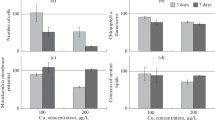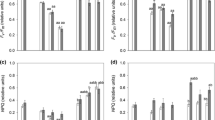Abstract
Three-phase dose responses of biological systems of different levels of organization are often called “paradoxical” because the biological effects are clearly manifested under low- and high-intensity treatments, but are absent during moderate-strength treatments. In this work, we found anomalous changes in the cell number of a green alga Scenedesmus quadricauda (Turp.) Breb. grown in the presence of the fungicide imazalil sulfate. At low imazalil concentrations (2.5 × 10–9–2.5 × 10–6 M), the slow increase in the cell number as compared to an untreated culture was not related to cell death. As seen by the dynamics of the population structure and cell functional characteristics (photosynthesis, thermal stability of photosynthetic membranes, etc.), the decrease in the growth rate at low concentrations of imazalil (2–10 × 10–9 M) was due to a long-term arrest of cell division in a fraction of the cell population rather than to a decrease in the rate of division. The absence of a toxic effect or even a slight stimulation of culture growth at moderate concentrations (0.05–1.25 × 10–6 M) was due to the resumption of cell division after a temporal cessation. At these concentrations, imazalil induced cell stress and adaptive elevation of cell tolerance to the fungicide (acclimation). Cell death was observed only at a high fungicide content in the medium (6.25 × 10–6 and higher). Thus, the three-phase (bimodal) dose response corresponds to two regimes (steady-states) of cell functioning which differ in cell sensitivity to external stimuli. The low-sensitivity state, which is characteristic of cells that have experienced stress, is likely to be the state known as “hormesis.”
Similar content being viewed by others
REFERENCES
Alexandrov, V.Ya., Reaktivnost’ kletok i belki (Cell Reactivity and Proteins), Leningrad: Nauka, 1985.
Reinhart, E., Hormesis und die Bewertung kleinster Dosen von Wirkstoffen, Biol. Med., 1998, vol. 27, pp. 51–54.
Kuzin, A.M., Idei radiatsionnogo gormezisa v atomnom veke (Idea of Radiation Hormesis in Nuclear Century), Moscow: Nauka, 1995.
Burlakova, E.V., Effect of Extra Low Doses, Vestn. Akad. Nauk, 1994, vol. 64, pp. 425–431.
Filenko, O.F., Vodnaya toksikologiya (Toxicology of Water Systems), Moscow: Chernogolovka, 1988.
Veselovsky, V.A. and Veselova, T.V., Lyuminestsentsiya rastenii. Teoreticheskie i prakticheskie aspekty (Plant Luminescence: Theoretical and Practical Aspects), Moscow: Nauka, 1990.
Veselova, T.V., Veselovsky, V.A., and Chernavsky, D.S., Stress u rastenii (biofizicheskii podkhod) (Plant Stress: A Biophysical Approach), Moscow: Mosk. Gos. Univ., 1993.
Veselova, T.V., Veselovsky, V.A., and Leonova, E.A., What Are the Implications of the Changes in the Heterogeneity of a Seed Population upon Its Accelerated Aging? Fiziol. Rast. (Moscow), 1999, vol. 46, pp. 477–483 (Sov. Plant Physiol., Engl. Transl.).
Tamiya, H., Synchronous Cultures of Algae, Annu. Rev. Plant Physiol., 1966, vol. 17, pp. 1–26.
Tamiya, H., Iwamura, T., Shibata, K., Hase, E., and Nihei, T., Correlation between Photosynthesis and Light-Independent Metabolism in the Growth of Chlorella, Biochim. Biophys. Acta, 1953, vol. 12, pp. 23–40.
Senger, H. and Krupinska, K., Changes in Molecular Organization of Thylakoid Membranes during the Cell Cycle of Scenedesmus obliquus, Plant Cell. Physiol., 1986, vol. 27, pp. 1127–1139.
Holzhutter, H.-G. and Quedenau, J., Mathematical Modeling of Cellular Responses to External Signals, J. Biol. Systems, 1995, vol. 3, pp. 127–138.
Grozdinskii, D.M., Radiobiologiya rastenii (Plant Radiobiology), Kiev: Naukova Dumka, 1989.
Veselovsky, V.A., Veselova, T.V., and Chernavsky, D.S., Three-Phase (Paradoxical) Dose Dependence of Cell Response to Environment Factors, Ross. Khim. Zh., 1999, vol. 43, pp. 49–54.
Author information
Authors and Affiliations
Rights and permissions
About this article
Cite this article
Prokhotskaya, V.Y., Veselovskii, V.A., Veselova, T.V. et al. On the Nature of the Three-Phase Response of Scenedesmus quadricauda Populations to the Action of Imazalil Sulfate. Russian Journal of Plant Physiology 47, 772–778 (2000). https://doi.org/10.1023/A:1026659228774
Issue Date:
DOI: https://doi.org/10.1023/A:1026659228774




